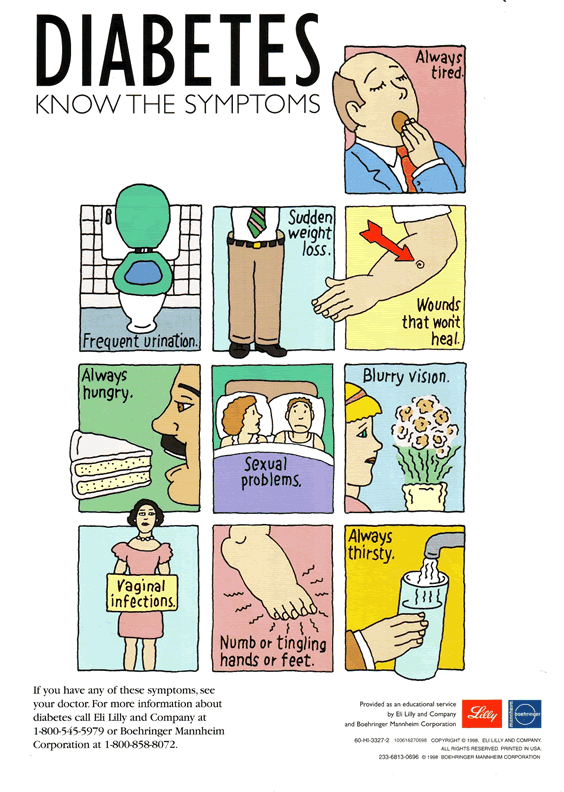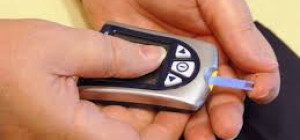Diabetes also known as Diabetes Mellitus (DM) is a group of metabolic diseases in which a person has high blood sugar levels for a prolonged period.
Diabetes Symptoms:
The symptoms of diabetes may seem harmless. However the early a person is diagnosed with diabetes, the greater risk of serious complications from this disease.
Some of the common symptoms of diabetes are listed below:
- Disproportionate thirst
- Frequent urination
- Intense hunger
- Unusual weight loss
- Weight gain
- Irritability
- Increased fatigue
- Cuts and bruises don't heal quickly or properly
- Blurred vision
- Itchy skin
- Frequent gum infection/diseases
- Numbness or tingling in hands or feet
- Skin or yeast infections
- Sexual dysfunction
- Swollen or red gums
What Is Type 1 Diabetes?
Type 1 diabetes is an autoimmune disease wherein a person's body has ruined his/her own insulin producing beta cells in the pancreas. Most patients with this type have developed conditions before the age of 40 and are unable to produce insulin. About 15% of all the people with diabetes have type 1 which is fatal unless they take exogenous insulin.
This is also known as childhood or juvenile diabetes as a large number of patients develop it after the age of 18. This condition is not preventable and diet or exercises cannot help reverse type 1.
What Is Type 2 Diabetes?
A person suffering from Type 2 Diabetes is either not producing enough insulin or suffers from insulin resistance where the insulin isn't working properly. The cause for type 2 diabetes is overweight and this usually appears later in life when compared to type 1. The early stage of type 2 patient may have insulin sensitivity which can be improved with medications. As this condition progresses, then the production of insulin in undermined and patient is given replacement insulin.
Excess abdominal fat is likely to bring on type 2 than the excess fat under skin. Nearly 22% of all the type 2 diabetic patients were obese during the onset of this condition. Patients need to perform more exercises, lose some weight and eat fewer carbohydrates. Despite cutting down carbs and dietary intake, the patients must monitor their diet and bodyweight as well as increase their physical activity.
The patient is usually prescribed anti-diabetic drugs orally which will usually improve their insulin production, regulate release of glucose and treat insulin resistance. If the beta cells impairs further then the patient is required to undergo insulin therapy for regulating the glucose levels.
Treatment & Care:
Successful treatment makes difference to long term health and helps achieve balanced diabetic care for both type 1 and type 2 diabetes. You should talk with your doctor regarding the best diabetes treatment and management strategy for your health. Treatment will help to keep your blood glucose level as normal as possible. Self management of diabetes by addressing your psychological, medical and lifestyle issues will help treating your medical condition.
There are a wide range of factors that play significant role for treating diabetes. Patients undergoing regular and successful treatment reduce the risk for developing diabetes complication.
- Treating Type 1 diabetes: This is a routine task as lack of insulin production by pancreas makes it difficult to control. Treating this condition requires strict regimen by carefully planning your diet, taking insulin injections daily, checking your blood glucose level at home for number of times per day and planning your physical activities.
- Treating Type 2 diabetes: This can be treated with exercises, diet control and home testing your blood glucose level and sometimes insulin or oral medication.
References:
- Rother KI (April 2007). “Diabetes treatment—bridging the divide”. The New England Journal of Medicine 356 (15): 1499–501.
- Nathan DM, Cleary PA, Backlund JY, Genuth SM, Lachin JM, Orchard TJ, Raskin P, Zinman B (December 2005). “Intensive diabetes treatment and cardiovascular disease in patients with type 1 diabetes”. The New England Journal of Medicine 353 (25): 2643–53.
- Ripoll, Brian C. Leutholtz, Ignacio (2011-04-25). Exercise and disease management (2nd ed.). Boca Raton: CRC Press. p. 25.
- Lambert P, Bingley PJ (2002). “What is Type 1 Diabetes?”. Medicine 30: 1–5.








